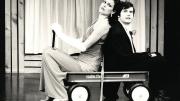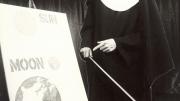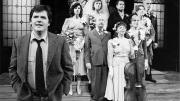In 1971, when Howard Stein was professor of playwriting at the Yale School of Drama, the program accepted a young playwright, Christopher Durang ’71. Stein burst into the office of Robert Brustein, the school’s dean, with the news. “We took in a kid from Harvard who is about 21 or 22 and who already has a subject: a scream for help in a world he knows provides none,” Stein announced. “So he keeps on screaming and laughs at it.”
Nearly four decades later, Durang’s characters are still screaming and the audiences still laughing. The cries erupt from the personal trials and primal anxieties of his own life, which his stagecraft somehow turns into hilarity. (He confesses that some mornings he “feels both grateful and bitter at the same time, which is a complicated feat.”) Durang wrings laughter from his troubled family (“My parents cared for each other and I was a wanted child, but they fought so much that it was hard to be around”) as well as from a bedrock hopelessness over the absence of a caring God.
Though many associate Durang with religious themes, religion has offered him little solace since he lost his Roman Catholic faith at 19, while at Harvard. Take his 1985 play, The Marriage of Bette and Boo, in which he traces the dissolution, through 33 scenes, of the marriage of an ideal 1950s couple closely modeled on his parents. Toward the end, the playwright’s proxy, Matt, reassures his mother, who is dying of cancer, that God is not punishing her for remarrying outside the church. “I don’t think God punishes people for specific things,” Matt declares. “I think He punishes people in general, for no reason.”
Durang’s best-known play is probably Sister Mary Ignatius Explains It All for You (1980), which opens with a doctrinaire lecture by a nun who outlines the Roman Catholic rulebook for life. But four of her former students, now thirty-something adults, puncture this dogma when they show up and confront Sister Mary with their actual lives, which include rape, abortion, unmarried parenthood, homosexuality, alcoholism, wife-beating, and the painful death of a parent from cancer. The action climaxes when the infuriated nun shoots two of the students, quickly justifying the homicides with airtight Catholic reasoning. Theology and reality rarely confront each other so bluntly on a stage, least of all in a comedy. Sister Mary Ignatius got rapt reviews and catapulted Durang into the first rank of American playwrights. “Only a writer of real talent can write an angry play that remains funny and controlled even in its most savage moments,” wrote Frank Rich ’71 in the New York Times. “Sister Mary Ignatius confirms that Christopher Durang is just such a writer.” (Though classmates, Durang and Rich didn’t know each other in college.)
Durang’s theatrical oeuvre—which includes 15 full-length plays and 35 one-acts—is radically unbalanced: all the works are comedies (see www.christopherdurang.com). But the laughter is dark; Durang is a modern master of black humor. His comedies spring from an imagination that breaks laws not only of drama, but of time and space. “One must guard oneself against the possibility of dying with laughter while watching a Durang play,” wrote Stein in a preface to Christopher Durang: 27 Short Plays, a 1995 collection, before comparing him to the Romanian/French absurdist Eugène Ionesco and to the ribald Greek playwright Aristophanes. “He has to be offensive to be effective, just as Aristophanes had to be offensive and Jonathan Swift had to be offensive.” Playwright Albert Innaurato (Gemini, The Transfiguration of Benno Blimpie), Durang’s Yale classmate and youthful collaborator, references his friend’s “extreme circumstances, crazy characters, and a certain amount of illogic. Chris is an extremely funny and creative writer.”
Brustein, now senior research fellow at Harvard, moved his theatrical enterprise from New Haven to Harvard in 1979, and the following spring launched the American Repertory Theatre, which has staged several Durang plays. Brustein calls him “a native American absurdist” who is “really committed to the family play.” In a 1997 essay on Durang, Brustein noted that “the quintessential American drama is and has always been a family drama—a work in which the writer lays his ghosts to rest at last, making peace with his past by exorcising the dead.” Indeed, many critics have compared The Marriage of Bette and Boo, which Brustein calls “a masterpiece,” to another great American family play, the far-less-jocular Long Day’s Journey into Night by Eugene O’Neill.
In both works, alcohol fuels rage and painful confrontations, but Durang, unlike O’Neill, includes some punch lines. In one Thanksgiving scene, borrowed directly from his childhood, an inebriated Boo spills gravy on a rug and then tries to vacuum it up as Bette repeatedly shrieks, “You don’t vacuum gravy! You don’t vacuum gravy!” It’s a hilarious scene onstage, but “The argument that followed the real event wasn’t funny,” Durang recalls. “There’s a distancing mechanism. When I was young, holidays could be hellish. Maybe I have an innate tendency to want to tame painful memories, to make them comical.”
As an only child amid a turbulent family, Durang must often have hoped for some kind of rescue, but actress Sigourney Weaver, his friend since they were classmates at Yale, isn’t sure that “a cry for help” really captures his outlook. “Maybe a yodel for help?” she suggests.
Durang’s black comedy will undergo an acid test in March, when his new play, Why Torture Is Wrong, and the People Who Love Them, opens at the Public Theater in New York. “It’s about torture and the war on terror,” Durang says, “but it is a comedy.” In this political play about “homeland insecurity,” the young female protagonist drunkenly marries a man she barely knows, and soon worries that he may be a terrorist. Her father, a right-wing ideologue, becomes an instant enemy of the new husband and works covertly to find out who the man is and what he may be planning. Meanwhile, the father himself seems to be heading a shadow government. “It becomes quite farcical and dark,” Durang explains, “but I slam it into fantasy in the last scene just so people can go home with some hope. Audiences are willing to go to dark places, but they don’t want to be sent home miserable.”
There surely were some forlorn moments in the small house in central New Jersey where Durang grew up. After his birth, his mother’s three subsequent pregnancies ended in stillbirths due to an Rh-factor incompatibility; Bette and Boo is rife with dead babies. “The first-born is exempt from the Rh issue,” he explains. “That was lucky for me, but I feel some survivor’s guilt.”
His father, F. Ferdinand Durang, was an architect—and one of many alcoholics on both sides of the family. “I felt like I was living in ‘Alcoholics-a-Poppin,’ ” Durang says. “Some got into AA, some were dry drunks. People who aren’t alcoholics have their own convoluted reactions to it. As a child I perceived that nothing in life worked out—nobody was able to solve any problems.” Durang’s mother, Patricia, who worked as a secretary at Bell Labs, had a way of prodding her drunken husband into fights; the couple separated when Durang was 13, to his great relief, and finally divorced when he was a college freshman.
Yet both sides of the family also valued the arts. “Ferd” Durang came from a long line of architects, and as far back as the 1700s the Durang clan had also produced actors, performers, and dancers: The Memoir of John Durang [1768-1822] is one of the earliest written journals by an American actor. Family members would speculate about whether young Christopher would go into architecture or theater. “They were very encouraging,” he recalls. His mother talked about theater a lot, and took her son to shows in New York (he recalls funny songs in fiorello) and to the Paper Mill Playhouse in Millburn, New Jersey, to see Betsy Palmer in The King and I.
At the age of eight, Durang announced that he was going to write a play, and produced a two-page comedy based on the “Lucy has a baby” episode of I Love Lucy. His mother showed the tiny script to Durang’s second-grade teacher at Our Lady of Peace School, who decided that the class would take an afternoon o and put it on. “I got to choose the actors,” he recalls. “It felt very fun.” He kept turning out plays, with longer and longer scripts.
At the Delbarton School, a private, all-male Benedictine secondary school in Morristown, New Jersey, Durang collaborated with his classmate Kevin Farrell on two musicals produced there, and, with Patricia Durang’s persistent backing, at a community theater, the 50-seat Summit Playhouse. A slight brouhaha ensued after the first Delbarton production when nuns from a private girls’ parochial school nearby forbade their students to act in any more Delbarton shows after witnessing a mildly risqué gesture—a strap dropping off a shoulder—in the first musical.
On entering Harvard, Durang received the Jack Lemmon Scholarship and as a freshman wrote, directed, and acted in his first “dark” play, Suicide and Other Diversions, at the Loeb Experimental Theater, with Bonnie Raitt ’72 in the cast. Yet auditions at the Harvard Dramatic Club didn’t land Durang any roles: “I began to feel that I must not be that good an actor,” he says. He moved toward musicals at the Agassiz Theater and as a sophomore sang in the chorus—Durang has an excellent singing voice—of How to Succeed in Business Without Really Trying.
But by then he was sliding into a two-year depression. He had a work-study job cleaning bathrooms two hours per day. “I was up until 2:00 a.m., then I’d sleep until 1:00, have lunch, clean bathrooms, and it would be 4:00,” he says. “I stopped going to classes, except for my favorite professor, William Alfred. I owed papers. I went to the movies nearly every day for four years at Harvard, but the only literature, movies, or theater I was responding to had a dark, despairing, tragic content. I found it comforting to see those.” Eventually a social worker at the University Health Services evaluated Durang. “They screened you to see if you were crazy enough for psychotherapy,” he says. “I passed!”
The Vietnam War was raging, and Durang marched for peace. For six months he went to a small experimental Roman Catholic mass celebrated at the Divinity School, where nuns wore mufti and participants talked about Vietnam. “I hoped that praying to God would help end the war,” Durang recalls. “But we had been praying for two years, and apparently God was sitting up there saying, ‘No, not quite yet. We’ll napalm tomorrow.’ At one Mass, a nun declared that she still felt hope. A little voice in me said, ‘I don’t. I don’t feel hope.’ That may have been my last day in church, except for funerals.”
Durang twice landed on academic probation, but managed to graduate on time in English. (“I don’t regret that there was no theater degree,” he says. “At Yale I arrived with a certain freshness because I hadn’t been saturated with theater at Harvard.”) The summer after his junior year he made up a failed course—a signal achievement. “I found that you could take an action and fix something that had gone wrong,” he says. “That was something no one in my family had done.”
This, plus an empathetic psychotherapist, helped lift Durang’s depression by senior year and he began writing again. Having sung the male lead in Annie Get Your Gun one summer, he amused himself writing The Greatest Musical Ever Sung, which told the Gospel stories as a musical comedy. In the Dunster House dining hall, he sang parodies like “You Can’t Get a Man with a Prayer,” and “Everything’s Coming Up Moses” to friends over dinner. When he directed the show for the Dunster Drama Society, a Jesuit teaching fellow wrote a letter to the Crimson complaining about its positive review and calling both the reviewer and the playwright “pigs trampling in a sanctuary.”
That letter went into Durang’s Yale application, along with a new play, The Nature and Purpose of the Universe, about “a housewife whose life is hell—then God sends down two angels to make her even more miserable.” He took the title from a grandiloquent pamphlet Harvard published amid the student unrest of the late 1960s, “The Nature and Purpose of the University.” Durang at first misread the last word as “universe,” thinking, “They have a pamphlet on that?” The play won a contest at Smith College and was staged there.
At Yale, he recalls, “Suddenly I was in a place where it was theater all day long, and cabaret shows every weekend.” Sigourney Weaver and Durang became fast friends and often ate together. Albert Innaurato was in their class, and Wendy Wasserstein joined them a year later. The 20 acting students included not only Weaver but Meryl Streep. Actors and directors were enrolled in the playwriting workshop. “Actors would read your play and the directors would rehearse them a little bit,” says Durang. “It’s such a great thing for playwrights to hear their work read aloud by good actors.”
Though Yale had accepted seven playwriting students, “They threw out nearly everyone except Chris and me,” says Innaurato. “They spoiled us a lot; they let us do what we wanted.” That included responding to a museum’s invitation for a theatrical piece on William Blake and Thomas Gray by reading some of the poets’ work in a museum gallery, then declaring that Blake and Gray had met on a summer-stock tour of The Glass Menagerie. Innaurato and Durang proceeded to portray the poets as two of that play’s female characters, with Innaurato dressed as a high priest and Durang in a cassock. This somehow segued into Sunrise at Campobello, with the two men, still in clerical costumes, playing Eleanor and Franklin Roosevelt, who decide to celebrate a mass and sing Kyrie eleison to the tune of Cabaret’s opening number, “Willkommen.” The museum “tried to throw us out for impropriety, outrageousness, and blasphemy,” says Innaurato. The pair also collaborated on a full-length play, The Idiots Karamazov, a wild, Monty Pythonesque take-o on The Brothers Karamazov starring Meryl Streep as Constance Garnett, the prolific real-life translator of nearly 70 works of Russian literature who nonetheless blurred authorial voices and dropped words and phrases she didn’t understand.
Brustein, who calls the cherubic young Durang “a choirboy with fingers dipped in poison,” admired Idiots enough to produce it at the Yale Repertory Theatre in 1974, a rare honor for a student play—“almost like winning the lottery,” says Durang, who played Alyosha Karamazov onstage and got both his first professional playwriting credit and his Actors’ Equity card. “The idea of being paid to work in theater was thrilling,” he says.
Furthermore, the creative atmosphere in New Haven had “that Dionysian spirit,” says Innaurato. “We could send everything up and be crazy. No one was worrying if it would work or not. We were making fun of religion, playing with homosexuality, cross-dressing, dirty words. People would get up and walk out. We were very cutting edge.” Weaver recalls that she “felt so excited to be there with these brave young writers who were writing these scathing attacks on our world.” (Innaurato, who now teaches at the University of the Arts in Philadelphia, says, “That’s gone now, entirely changed. Young people are not irreverent; they don’t make fun of things. They take things seriously.”)
In 1975, Durang moved to Manhattan, where he would live for the next two decades. (Since 1997, he has lived with his longtime partner, fellow writer and performer John Augustine, in a 1749 stone farmhouse in eastern Pennsylvania; he makes weekly trips to Manhattan where, since 1993, he and Marsha Norman have taught playwriting at the Juilliard School.) He soon brought some of his iconoclastic energy to both off- and off-off-Broadway theater. His one-act Titanic, with a plot of “blinding complexity,” according to the New Yorker (Durang freely admits that dialogue, not plot, is his strong suit), opened in February 1976. In the play, the luxury liner does not sink, though several passengers wish it would, and the captain’s daughter tries to accomplish as much by drilling holes in the hull. The captain does spot an iceberg approaching and the audience hears distressing sounds of a ship apparently hitting an iceberg, but that turns out to be a sound-effects record that the captain’s unstable wife has played over the ship’s public-address system. Mainstream critics like Walter Kerr of the New York Times lacerated the play. The criticism was so ferocious that Durang asked his agent, Helen Merrill, “Will anybody do a play of mine again?” She replied, “Oh, people forget reviews.”
Merrill was soon proved right. In the summer of 1976, at the Eugene O’Neill National Playwrights Conference in Connecticut, Durang’s play A History of the American Film made such an impact that the following year, with Merrill’s help, it received a rare “triple premiere”: three separate productions within a four-month period—at the Hartford Stage Company, the Arena Stage Company in Washington, D.C., and the Mark Taper Forum in Los Angeles. It later ran on Broadway and received a Tony nomination for best book of a musical. (Durang has also won four Obie awards for writing and received the 2006 Harvard Arts Medal.)
He continued to act and sing. With Weaver, he wrote and performed Das Lusitania Songspiel, a crackpot parody of a Bertolt Brecht/Kurt Weill musical. Originally a curtain raiser for Titanic, it became a late-night cult hit off-Broadway when the pair revived it in the winter of 1979-80 as an 11 p.m. cabaret act. The collaborators had fun playing Weaver’s six-foot stature o against Durang’s five-foot-seven frame. “We were backstage in evening dress, telling each other, ‘Relax! Relax! Have fun!’” says Weaver. “I don’t think I’ve ever had a better time doing anything.”
In 1979, when Durang was 30, his mother died after battling breast and bone cancer for seven years; the last time she walked was at the New York opening of A History of the American Film. “I wished I had still been a believer, in terms of offering her comfort,” Durang says. “I realized how hard it was to be with someone facing a terminal illness and not be able to say, ‘Oh, you’re going to heaven.’ It made me think about how the Roman Catholic Church had an answer for absolutely everything. I had this impulse to write a play where some religious person comes out and explains every single thing in the universe and how it works.” In Sister Mary Ignatius Explains It All for You, the title character does exactly that, and gets laughs with clarifications like, “You can expect to be in purgatory for anywhere from 300 years to 700 billion years. This may sound like forever, but don’t forget, in terms of eternity, 700 billion years does come to an end.”
The sensational reception of Sister Mary led to many productions throughout the 1980s (it is less popular today, but still performed). It drastically raised Durang’s profile and opened up new opportunities. Beyond Therapy, his most lighthearted and mainstream work, opened on Broadway in 1982, starring Dianne Wiest and John Lithgow ’67, Ar.D. ’05. The comedy, about a couple who meet via a “personals” ad, lampoons their psychotherapists who, as Brustein wrote, “prove to be more aggressive, and often more loony, than their patients.” Weaver, who played the female lead in an earlier off-Broadway version, calls it “a wonderful and upsetting story,” adding, “I know we all went back into therapy after that play.” Robert Altman directed a 1987 film version—for which, Durang says, “He rewrote the script and took the psychology out. He made everyone act crazy, but without a real connection to who their characters were.”
Durang himself has written a score of screenplays and teleplays, both produced and unproduced. His website explains that “between 1982 and 1990, Durang wrote 3,177 versions [of Sister Mary] for two different sets of independent producers.” In 2001, Showtime finally aired it as a TV film starring Diane Keaton. None of his three sitcom pilots, such as Dysfunction, The TV Show (1990), in which family therapists consistently fail to solve the problems of their troubled client families, has made it to air.
Durang’s modus operandi does not dovetail well with studio “pitch meetings” at which writers lay out an entire story in broad strokes, attempting to sell the concept to Hollywood buyers. “Sit down and outline a story? My brain just doesn’t work like that,” he says. “I have to write the dialogue and discover the story as I write it. You need to get out of your characters’ way and let them lead you.”
And the finished script, of course, is only a starting place: Durang, who has done a good deal of acting, is well aware of how the cast and their performances crucially determine whether such a fragile thing as comedy plays with an audience. Admittedly, there are times when “a performance goes so right that you say, ‘I wish we could have filmed it and showed it as, “This is the way it should be done,”’” he says.
But live theater offers irreplaceable rewards. Consider actress Elizabeth Franz, the original Sister Mary Ignatius. At the start of the play, Franz talked directly to the audience, “and that could be quite alive, even electric, in a way that could not be done on film,” Durang explains. “When the audience would laugh at something she’d said, she would smile broadly, as if she were receiving both affirmation and agreement—and that made them laugh all the more, laughing both at the absurdity of what she was saying and that she was taking it as approval. There is a genuine energy exchange in theater between audience and performer, something really powerful.”
Acting in a Durang play, says Sigourney Weaver, who has done many of them, means “You’re always standing on the edge of the void. Usually I would play a rather cracked character, the vulnerable person who was trying to survive. You’re a very nice person holding on for dear life, hoping some act of kindness from the universe will help you get through to the next moment. The emotional through-line always has a great deal of hope and determination; you root for his characters so strongly. And he fills you with the dread of acting badly or crazily—it’s an ordered world where cruelty can come in from any angle and ruin everything. The danger is always lurking, just in the next room. Chris’s plays are like messages in a bottle: you open it and it scares you to death. But you’d better listen.”












